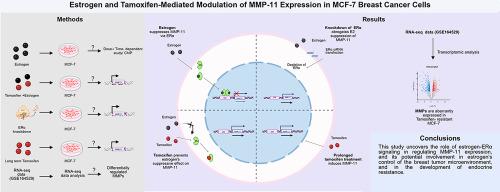Expression of MMP-11, an estrogen-suppressed gene in MCF-7 cells, is elevated upon acquisition of tamoxifen resistance
IF 0.9
Q4 GENETICS & HEREDITY
引用次数: 0
Abstract
Matrix metalloproteinase-11 (MMP-11), also known as stromelysin-3, is a member of a large family of zinc-dependent proteinases. Known to be expressed in breast tumor stroma, the epithelium, and the associated mononuclear inflammatory cells, its expression is associated with invasion, metastasis, and poor clinical outcomes and survival rates. Despite the known effects of estrogen on extracellular matrix remodeling, and breast cancer metastasis, the role of MMP-11 therein is not understood. Here, we show that estrogen suppresses MMP-11 expression in MCF-7 breast cancer cells via a mechanism that involves binding of the estrogen receptor α (ERα) to an estrogen response element located in the intron-1 of MMP-11. ERα knockdown alone upregulates MMP-11 expression, highlighting its crucial role in this regulatory axis. Additionally, the anti-estrogen tamoxifen (4-OHT) blocks estrogen-mediated MMP-11 suppression. However, prolonged 4-OHT exposure or 4-OHT resistance leads to increased MMP-11 expression. This suggests that MMP-11 may play a role in 4-OHT resistance, potentially leading to a more aggressive tumor phenotype. Our study underscores the importance of estrogen-ERα signaling in breast cancer progression, emphasizing the need for further investigation into MMP-11's role in 4-OHT resistance and cancer metastasis.

MCF-7细胞中雌激素抑制基因MMP-11的表达在获得他莫昔芬耐药后升高
基质金属蛋白酶-11 (Matrix metalloproteinase-11, MMP-11),也被称为基质蛋白酶-3,是锌依赖性蛋白酶大家族的一员。已知在乳腺肿瘤间质、上皮和相关的单核炎性细胞中表达,其表达与侵袭、转移、不良临床结果和生存率相关。尽管已知雌激素在细胞外基质重塑和乳腺癌转移中的作用,但MMP-11在其中的作用尚不清楚。本研究表明,雌激素抑制MCF-7乳腺癌细胞中MMP-11的表达,其机制涉及雌激素受体α (ERα)与位于MMP-11内含子-1中的雌激素应答元件的结合。ERα敲低可上调MMP-11的表达,突出其在这一调控轴中的重要作用。此外,抗雌激素的他莫昔芬(4-OHT)可阻断雌激素介导的MMP-11抑制。然而,长时间的4-OHT暴露或4-OHT抗性会导致MMP-11表达增加。这表明MMP-11可能在4-OHT耐药中发挥作用,可能导致更具侵袭性的肿瘤表型。我们的研究强调了雌激素- er α信号在乳腺癌进展中的重要性,强调需要进一步研究MMP-11在4-OHT耐药和癌症转移中的作用。
本文章由计算机程序翻译,如有差异,请以英文原文为准。
求助全文
约1分钟内获得全文
求助全文
来源期刊

Gene Reports
Biochemistry, Genetics and Molecular Biology-Genetics
CiteScore
3.30
自引率
7.70%
发文量
246
审稿时长
49 days
期刊介绍:
Gene Reports publishes papers that focus on the regulation, expression, function and evolution of genes in all biological contexts, including all prokaryotic and eukaryotic organisms, as well as viruses. Gene Reports strives to be a very diverse journal and topics in all fields will be considered for publication. Although not limited to the following, some general topics include: DNA Organization, Replication & Evolution -Focus on genomic DNA (chromosomal organization, comparative genomics, DNA replication, DNA repair, mobile DNA, mitochondrial DNA, chloroplast DNA). Expression & Function - Focus on functional RNAs (microRNAs, tRNAs, rRNAs, mRNA splicing, alternative polyadenylation) Regulation - Focus on processes that mediate gene-read out (epigenetics, chromatin, histone code, transcription, translation, protein degradation). Cell Signaling - Focus on mechanisms that control information flow into the nucleus to control gene expression (kinase and phosphatase pathways controlled by extra-cellular ligands, Wnt, Notch, TGFbeta/BMPs, FGFs, IGFs etc.) Profiling of gene expression and genetic variation - Focus on high throughput approaches (e.g., DeepSeq, ChIP-Seq, Affymetrix microarrays, proteomics) that define gene regulatory circuitry, molecular pathways and protein/protein networks. Genetics - Focus on development in model organisms (e.g., mouse, frog, fruit fly, worm), human genetic variation, population genetics, as well as agricultural and veterinary genetics. Molecular Pathology & Regenerative Medicine - Focus on the deregulation of molecular processes in human diseases and mechanisms supporting regeneration of tissues through pluripotent or multipotent stem cells.
 求助内容:
求助内容: 应助结果提醒方式:
应助结果提醒方式:


